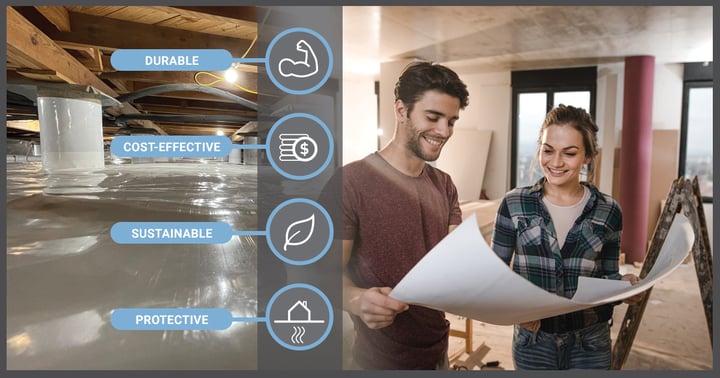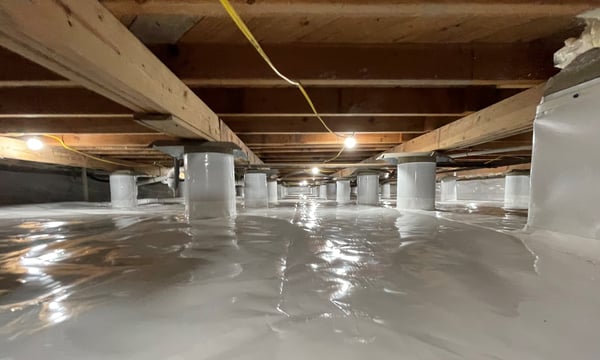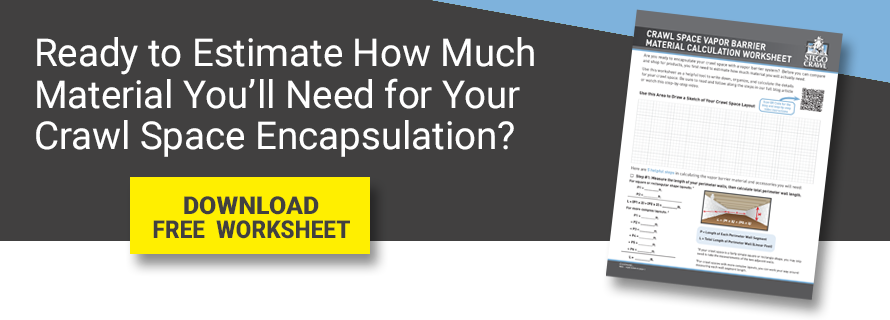What Supplies Will I Need to Encapsulate My Crawl Space?
Here's the Complete List of Everything You Need from A to Z for Your DIY Crawl Space Project

When I tackle a DIY project, I’m just like you. I like to make sure I do all my research ahead of time and have everything I need on hand to make my project as smooth as possible. In one of our most popular posts “Read This Before You Choose Your Crawl Space Liner – 3 Key Questions to Ask”, I go into a detailed review of the important things to look for when selecting a crawl space vapor barrier.
Well, now I want to go a little further and talk about all the supplies recommended to conduct a successful install, from the liner itself to the accessories and installation tools. It’s not only important for the long-term performance of the vapor barrier system (and the home) but can play a big role in the ease and efficiency of the installation.
This article is intended to provide a deeper look into some of the considerations for selecting the appropriate crawl space encapsulation supplies for an efficient and effective installation. What this article will not cover is the other supplies you’ll need for mold removal, air sealing, water drainage (e.g. sump pump), insulation, and mechanical dehumidification.
If you already have what you need and are gearing up for a vapor barrier installation, you might jump ahead to our Step-By-Step Crawl Space Encapsulation Guide.
Where to Start: Crawl Space Vapor Barrier Selection
The start of any crawl space encapsulation project should be an analysis of the moisture vapor barrier itself, so let’s start there. If you are reading this, let’s assume your goal is to find a vapor barrier liner that:
- effectively stops soil vapor movement into your crawl space
- is durable, and
- won't need to be repaired or replaced later on.
Evaluating and selecting a liner with the appropriate performance for your home is critical. Check out Is a Class I Vapor Retarder Good Enough for Crawl Space Encapsulation? to learn more.
.jpg?width=600&name=Stego-Crawl-CliffsNotes-Supporting-Graphic-600x337px%20(2).jpg) Here are the CliffsNotes: no matter the geography, climate, or crawl space conditions, we recommend vapor barrier liners that have a very low water vapor permeance (less than 0.01 perms is ideal) and meet ASTM E1745, a robust performance standard for vapor retarders and barriers.
Here are the CliffsNotes: no matter the geography, climate, or crawl space conditions, we recommend vapor barrier liners that have a very low water vapor permeance (less than 0.01 perms is ideal) and meet ASTM E1745, a robust performance standard for vapor retarders and barriers.
This standard is important because it references testing methods (found in ASTM E154) which are setup to simulate a below-slab or crawl space environment for the vapor barrier during installation and over time. Therefore, a vapor barrier that meets ASTM E1745 has been engineered with performance characteristics uniquely suited to translate to effective long-term vapor protection in a crawl space. This is not something you get with just any generic plastic sheeting at a local home supply store.
There are a few other crawl space vapor barrier liner features to consider that may benefit your project:
- Roll Size and Weight: every crawl space can be unique…the size of the access into the crawl space, the height between the dirt and joists, the height of the wall, the presence and spacing of columns or pony walls, etc. You’ll want to find vapor barrier rolls that may be optimized for covering the ground and lapping up the perimeter wall; this will ease your installation and help reduce waste. The actual length of the roll core is important, too: make sure it’s small enough for the access to the crawl space, or you’ll add a few steps to your project (measuring, cutting the vapor barrier outside, folding/rolling it back up, carrying it into the crawl space in pre-cut sections).
- Material Composition: the vapor barrier in your crawl space is intended to help improve indoor air quality in your home; keeping it healthy, comfortable, and free of odors. It wouldn’t make much sense if the vapor barrier itself released any harmful toxins or unpleasant odors.
- If you are the type of person who wants to better understand what makes up the products that go into your home, and whether any ingredient poses a health hazard to you and your family (think paint or household cleaning products), then it makes sense to apply the same logic to the vapor barrier system in your crawl space. Due to stack effect, which is the natural movement of air in a home from lower to upper levels, what is in your crawl space can eventually migrate into your living space. So, consider an unvented, conditioned crawl space as part of the interior of your home, even if you don’t spend much time down there.
- Most crawl space vapor barriers should be fairly inert and stable (won’t off-gas), but some specific things to look for are: products that have zero VOCs (Volatile Organic Compounds), produce no odor, and, even better, have published ingredient disclosure and health hazard information (like a Health Product Declaration).
- Aesthetics: this may be obvious, but whether you are a homeowner or a crawl space contractor, achieving that desirable finished look is most likely important. Fortunately, you can get that clean, professional look on any budget. The most popular is usually a bright, solid white color, which helps brighten up the crawl space.

Encapsulate Properly with Sustainable and Safe Crawl Space Accessory Products
Next, you’ll want to think about the accessories within the vapor barrier system…the tapes, sealants, and fasteners to ensure the vapor barrier is well sealed and secured in the crawl space. You’ll want to have the proper supplies on hand to do the job correctly (and with minimal frustration). Some of the same considerations above may apply here. For example, the color of the supplies is important to complement the vapor barrier for a consistent, clean look.

Even more, think about sealants and adhesives that ensure a sustainable and safe system is being added to your home. These products need particular attention, given their wide range of options and VOC emission levels. In fact, some jurisdictional regulations now require low-VOC emission adhesives and sealants be used inside buildings and homes. Fortunately, there are accessory options available for crawl space vapor barrier encapsulation with low VOC emissions, including some with industry-established testing.
Incorporate verifiably safe products with our Certified Clean Air GOLD accessories: StegoCrawl Tape and StegoTack Tape.
Here’s a closer look at both the purpose of the vapor barrier system supplies and the considerations you’ll need to select the right ones for your project:
- Seaming Tape: should provide initial and long-term adhesion to seal the seams of the vapor barrier together and seal any utility penetrations or holes. This is important for moisture and vapor protection and to keep the vapor barrier and crawl space clean. You can learn more about how to select the right seaming tape in this article: 6 Things to Look for When Buying Crawl Space Vapor Barrier Seaming Tape.
Most vapor barriers engineered for crawl space encapsulation will have seaming tape uniquely designed to use with it. Mixing and matching liners and seaming tapes can create issues, given the unique formulations and composition of materials. That’s why it may be especially useful to choose products from a manufacturer or dealer that offers a full, integrated system. - Perimeter Sealing: the vapor barrier should not only cover the ground but extend up the perimeter foundation wall and any interior columns or pony walls, and then the vapor barrier should be sealed. The goal is to help attach the vapor barrier and create a consistent seal to prevent moisture and soil vapor movement. Your walls’ composition will probably dictate what to use here. In most cases:
- a masonry block or cast-in-place concrete foundation wall offers a relatively smooth surface to allow for a double-sided perimeter sealing tape.
- a stone or irregular wall may present a trickier surface for an adhesive tape, so a low-permeance mastic type sealant provides a better option.
- Mechanical Termination: in addition to creating a consistent seal at the perimeter, it's a good idea to mechanically fasten the vapor barrier to the wall. The weight of the liner at the perimeter, freeze/thaw cycles, gravity, etc. can all take a toll. Mechanically fastening can help ensure you’ll only need to do the job once.
- There are a variety of options for mechanically fastening the vapor barrier, but one approach is to insert fasteners or concrete screws and a termination bar into pre-drilled holes (be sure to use a rotary hammer drill). Although it can take time, this is a simple and economical approach with common tools and hardware.
- Another option is using a powder-actuated or similar nail gun to shoot in concrete nails with washers. For the average DIYer, this may be intimidating or impractical, but it certainly can make this part of the installation go more quickly.
 Other Crawl Space Encapsulation Supplies to Have on Hand
Other Crawl Space Encapsulation Supplies to Have on Hand
From personal experience, here are a few more supplies that you may not have thought about but can make a big difference when doing a crawl space vapor barrier installation. Each one of these you can find for $5-20:
- Chalk Line: for the perfectionist….snapping a chalk line on your perimeter wall will provide a straight and level (laser level is great here too) visual guide to apply your perimeter sealing tape or sealant.
- Headlamp: good lighting is important when installing the vapor barrier. A headlamp will provide some extra focused light where you are working while keeping your hands free.
- Knee Pads: they call it a crawl space for a reason…no matter how forgiving the dirt may appear, knee pads are well worth having for crawl space work.
- Stiff Bristle Brush: the perimeter walls or interior columns will inevitably have dirt or dust on them, so a stiff bristle brush is a great tool for removing dirt and debris prior to applying the double-sided tape or sealant.
- Rubber Roller: a hard, rubber hand roller works great to apply consistent pressure to the tapes on the wall or seams…and gives your hands and fingers a break.
Finally, before you finalize your shopping list, don’t forget these necessary supplies as well: utility knife, measuring tape, personal protective equipment (work gloves, eye protection, mask, etc.), trash bags, marker, and dry rag.
Encapsulating your crawl space can be a lot of work, but those who have done it know the results speak for themselves. Having the right supplies on hand ensures you’ll enjoy all those benefits the first time, and for a long time.

Written by Tom Marks
Tom Marks is the Business Development Project Manager with Stego Industries, LLC. He has been with Stego since 2007, serving many years as the Rocky Mountains Regional Manager. Now, his focus is geared toward vapor barrier solutions for new and existing homes as the Product Manager of the StegoHome and StegoCrawl brands. In addition, Tom serves as Sustainability Manager, overseeing Stego’s leadership in holistic product and corporate sustainability. Tom enjoys working with a wide range of project team members and customers to incorporate effective sub-slab vapor protection and create healthy, sustainable homes and buildings.
- Stego (26)
- StegoCrawl (24)
- Stego-Awareness (17)
- StegoHome (15)
- Case Studies (14)
- StegoCrawl-Consideration (12)
- StegoCrawl-Awareness (11)
- Customer Stories (9)
- Stego-Consideration (9)
- Pango (8)
- StegoHome-Consideration (8)
- Beast (7)
- How to Install (7)
- StegoHome-Awareness (7)
- Drago (5)
- Pango-Awareness (5)
- Beast-Awareness (4)
- Beast-Consideration (3)
- Drago-Awareness (3)
- Pango-Consideration (3)
- Stego IQ (3)
- Drago-Consideration (2)
- StegoCrawl-Decision (2)
Popular Posts
Stay Connected.
Enter your email below.








Post Comments